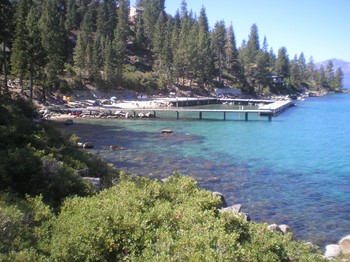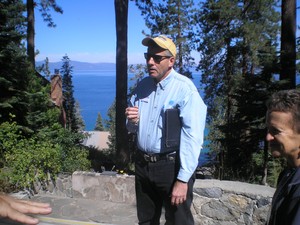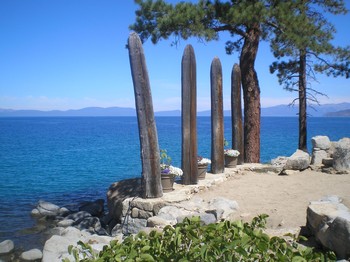Bedford Holmes likes to use the Celtic spiritual idea of “thin places” when talking about the palpable sense of God’s presence at Zephyr Point Presbyterian Conference Center (ZPPCC) here on the shores of majestic Lake Tahoe.
“It starts of course with the biblical witness that ‘the heavens declare the glory of God,’” Holmes ― the executive director of ZPPCC for the past five years ― explains. “The Celts believed that there are places of grandeur around the world, ‘thin places,’ where the fabric between heaven and earth is very thin. In these places people can more easily encounter God, see God better and re-envision their relationship to God.
“Zephyr Point is unquestionably one of those places.”
Nestled in the Sierra Nevada mountains along the California-Nevada border, Lake Tahoe is 22 miles long and 12 miles wide, with a surface area of almost 192 square miles. It is the deepest lake in North America at 1,600 feet and sits at an elevation of 6,200 feet.
“We like to say the air is cleaner here but there’s not as much of it,” Holmes says. “At this altitude you have to slow down, but here God is also telling us to slow down. We’re peppering the grounds with benches to point people to places of quiet and reflection.”
Zephyr Point Presbyterian Conference Center dates back to 1924. It was the Roaring Twenties, and concerned parents and church leaders were intensely interested in providing inspirational experiences for young people.
A youth event, sponsored by the then Synod of California, was held in August of that year at Comstock Lodge adjacent to the current site of ZPPCC. Church leaders began looking around the area for a permanent site and discovered that a 30-acre parcel next to Comstock was available. Some shrewd bargaining led to the purchase of that parcel for $6,000, including a half-mile beachfront.
For the first 10 years of ZPPCC, accommodations consisted of tents and meals were prepared over campfires. In the mid-1930s two dormitories were constructed ― Dobbins Hall, which also served as Zephyr Point’s worship space, and Lakeview Lodge. A third dormitory, Hubbard Lodge, was built in the 1950s.
Meanwhile, tent sites gave way to rustic cabins ― 43 in all. ZPPCC continued in that mode ― three public buildings and 43 privately owned cabins ― until 1995, “when we started to move to a whole other level,” Holmes says.
The Tahoe Center was dedicated in 1995, with 43 hotel-style rooms and several meeting spaces of various sizes. In 2006, Tallac Center was completed, adding 59 more hotel-style rooms and state-of-the-art meeting facilities. With these additions, ZPPCC became the largest Presbyterian conference center in the western United States. Last year, ZPPCC welcomed 23,000 guests and 450 groups.
To better coordinate facilities and programs, the ZPPCC board of directors ― composed of Presbyterian teaching and ruling elders ― converted all the private cabin leases to ZPPCC ownership in the early 2000s. The conference center is jointly owned by the Synod of the Pacific and the Synod of Southern California and Hawaii.

The half-mile of Lake Tahoe waterfront at Zephyr Point includes a swimming beach and two docks for sunbathing, water sports and star-gazing at night. —Jerry L. Van Marter
“We have a monopoly on faith-based residential activities on Lake Tahoe,” Holmes says, “so all of Christendom comes here.” During this week alone, the conference center sponsored a conference called “Kaleidoscope,” which brings amateur and professional artists together for a week of such activities as writing, quilting and other stitchery, scrapbooking and painting; a faculty retreat for Golden Gate Baptist Seminary in Marin County, Calif.; and “Companions on the Inner Way” ― a spirituality retreat program created by San Francisco Theological Seminary and now run by Seventh Avenue Presbyterian Church in San Francisco.
Activities at Zephyr Point Presbyterian Conference Center are guided, Holmes says, by “God’s three revelations: the Bible, people whose lives are a witness to Jesus Christ, and the ‘biggie’ for us ― creation itself as God’s great revelation.”
Holmes, a former history and geography teacher who directed a Quaker retreat center in Oregon before coming to Zephyr Point, says “we don’t have to speak or teach much because God speaks in capital letters here at Zephyr Point.”
A key to ZPPCC’s recent growth, Holmes continues, “is a staff that’s sensitive to guests and trained to help them experience the presence of God here.” In that regard, the ZPPCC staff (they call themselves “the crew”) have adopted an acronym: Care, Respect, Encouragement, Welcome.
“That’s the atmosphere we want to create,” Holmes says. “There are all sorts of teachable moments when people come to us. Through our attitude and service we encourage people to focus on God.”
The crew is studying the Great Ends of the Church “and talking through them as part of our mission,” Holmes says. “As a synod facility, we’re trying to focus on helping to train church leaders ― clergy and lay ― so we want to help them in whatever ways we can to apply the Great Ends of the Church to more effective practice of ministry.”

Bedford Holmes, executive director of Zephyr Point Presbyterian Conference Center. —Jerry L. Van Marter
With the 90th anniversary of Zephyr Point coming Aug. 23-25, 2014, Holmes says the conference center is “determined to become the regional training center for the PC(USA) in the West. What floats our hull right now is the outside groups that rent our facilities. Only about 20 percent of them are Presbyterian and hardly any are national ones. So we’ve got a lot of work to do.”
Building on its current momentum, ZPPCC has embarked on a $3 million capital campaign called “Fresh Horizons.” Funds will be used to retire the debt on the Tahoe Center (a little over $1 million), retro-fit some of the older buildings on campus, make a number of environmental upgrades (including solar panels to reduce utilities costs) and to expand ZPPCC’s programmatic activities, particularly with children and youth.
Holmes also wants Zephyr Point’s “thin place” to become a center for denominational peacemaking and reconciliation. “Our ministry here is about providing the environment where people can encounter God more fully, see God better, and embrace a clearer vision of their relationship to Jesus Christ and each other as sisters and brothers in Christ.
“With all the dissonance in the denomination,” he continues, “we’re like Switzerland ― a neutral place for détente.”

